 |
|||||
|
|||||
| Preview of Stamps Catalogue: VOLUME 1 |
 |
|||||
|
|||||
| Preview of Stamps Catalogue: VOLUME 1 |
Return To Catalogue - Hanover 1850-1852 - Hanover 1853 Value and Crown issue - Hanover 1859 King George V issue - Cancels, Postal stationery - Hanover Fournier forgeries - Hanover private issues (Mercur)
Note: on my website many of the
pictures can not be seen! They are of course present in the catalogue;
contact me if you want to purchase it.
30 Silbergroschen = 24 Gutegroschen = 1 Thaler
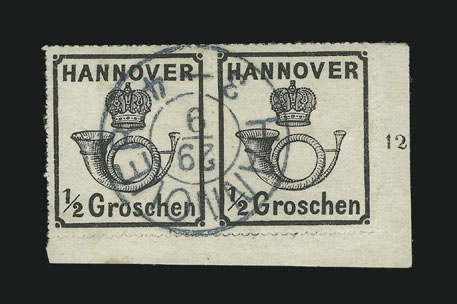
1/2 Groschen black
For the specialist, this stamp was issued imperforated or rouletted (1864). Reprints exist.
Value of the stamps |
|||
vc = very common c = common * = not so common ** = uncommon |
*** = very uncommon R = rare RR = very rare RRR = extremely rare |
||
| Value | Unused | Used | Remarks |
| 1/2 g | R | R | Imperforate With red gum: RR Reprint: * |
| 1/2 g | RR | RR | Rouletted (1864), white or red gum |
In the genuine stamp the horn appears much lighter than the text and the border. The genuine stamps were printed on paper, which shows irregular spots when held against the light (according to: 'The Forged Stamps of all Countries' by J.Dorn). The crown should be at a slight distance from the second 'N' of 'HANNOVER'.
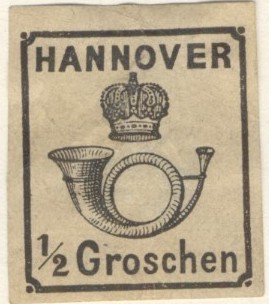



Probably Goldner reprints.

A mini sheet of 10 Goldner reprints
with tete-beche stamps. Stamp dealer Goldner made private(?)
reprints of this stamp (he is also known for the enormous
quantity of reprints he made of Helgoland). Goldner reprints have
a single line instead of two lines as connection between the
mouthpiece and the horn. Reduced size. He also made reprints in
sheets of 50 (10 x 5) with no tete-beche stamps.

Most likely a reprint sheet of 50 stamps.
Forgeries:


Forgery with a very sharp upper part of the '1'. The genuine
stamp has a flat upper part of the '1'. There are many other
minor differences when compared with a genuine stamp.

In the genuine stamp, if the fraction line of the "1/2"
would be continued upwards it must touch the "R" of
"HANNOVER". In the forgery above it would touch the
"V".

Forgery with a too narrow "G" of "Groschen",
the "s" of this word is slanting forward. The horn
opening is slanting to the left. The crown has a too large
ellliptic bottom part (not flat enough). The upper dots in the
corners are placed too high. I've only seen this forgery with a
circular cancel with unreadable text ("ZEITUNGS
EXPEDITION" maybe?).

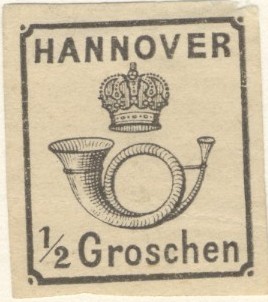
Dots in the corner too small (especially in the lower left part).

Forgery with a large upwards directed bottom right part of the
"2". The "1" has an angle at the bottom. The
cross on the crown is too clear and touches the second
"N" of "HANNOVER".

This is a Spiro forgery with the left hand side of the mouthpiece
of the horn straight instead of curved. This forgery has
guidelines outside the stamp. The bottom right part of the '2' is
different from a genuine stamp.




This forgery has the left side of the horn too narrow, the crown
is also too narrow, the circular parts of the outer frameline are
not circular enough. The top left side of the "1" is
too small. It is often cancelled with "LUNEBURG" or
"HANNOVER" in a single circle with no date. On the
right side of the crown, the pearls are at a relatively large
distance from the rest of the crown (resulting in a noticable
white space). Click here for more
forgeries of the same kind. However, it exists with other cancels
(see the first image above).

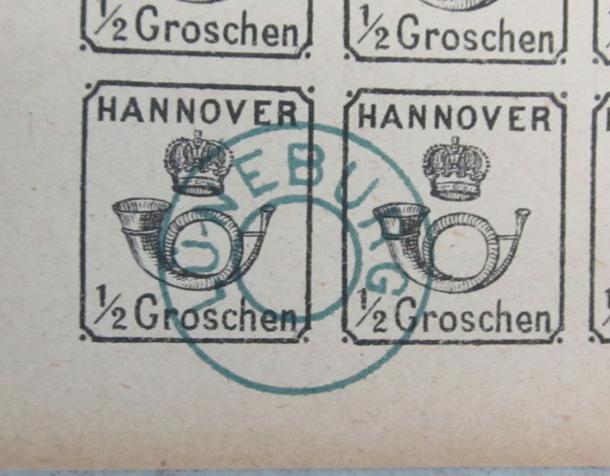
Sheetlet of 25 of these forgeries.

In this forgery the opening of the horn at the left hand side is
not big enough. Also the "S" of "Groschen"
has a weird shape (top part too large).
Fournier forgeries


Fournier forgery, first type, with "HANNOVER 8 11 44"
cancel
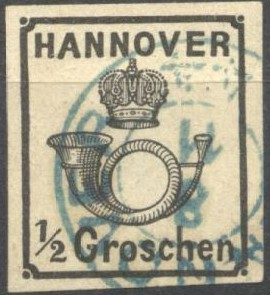
Fournier forgery, second type, with forged "HANNOVER 8 11
44" cancel
The above Fournier forgeries bear the cancel "HANNOVER 8 11 44" in a double circle, exactly the same cancel as can be found in 'The Fournier Album of Philatelic Forgeries' (click here for more Hanover Fournier forgeries). According to the American Philatelic Society forgery sheets, there are two types of Fournier forgeries of this stamp. The first type has the top of the crown almost touching the second "N" of "HANNOVER". The mouthpiece is attached to the horn by two horizontal lines (as in the genuine), but at the attachment at the left hand side there is a white opening (should be a solid black line). At the other end of these lines, just below the mouthpiece, an ellipse can be found (it should be a circle). The second type Fournier forgery has an indentation which goes too deep in the upper part of the "n" of "Groschen". Also the left hand side upper side of the "1" is too thin.
Sperati also made a forgery of this stamp
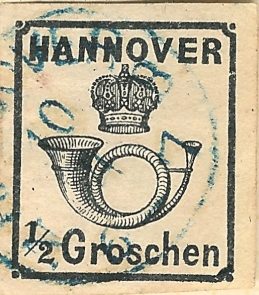
(Image obtained from Richard Frajola's website)

'Proof' of Sperati with violet 'REPRODUCTION INTERDITE' and
signature of Jean de Sperati
In the above Sperati forgery, there is a white spot in the top of the 'G' of 'Groschen'. Also, there is a break in the outer right frameline, just below the "R" of "HANNOVER". In my view, the 'smudge' below the 'ro' of 'Groschen' is also typical of a Sperati forgery. I've also seen it with a straight blue "RITZEBUTTEL" cancel
The German Philatelic Society describes another forgery (Type XII), in which the shading lines on the horn on the left hand side are all parallel to the horn (the perpendicular lines are missing, i.e. there is no cross-hatching). Sorry, no image available yet of this forgery.

Sheet with 'reprints'; note that the frameline below the 'sch' of
'Groschen' is deformed in all stamps.

A forgery with the right leg of the "R" of
"HANNOVER" straight instead of bend (reduced size).
What are these, the same stamps in the colours green and red?:


(Mystery stamps in green and red)

Bogus red 1/2 g stamp with no shading on the front part of the
horn (above the "G").
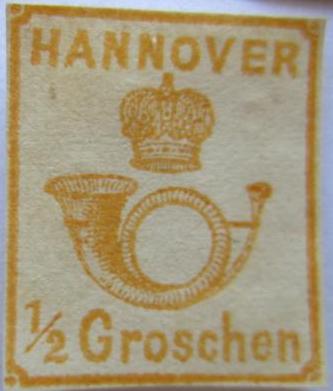
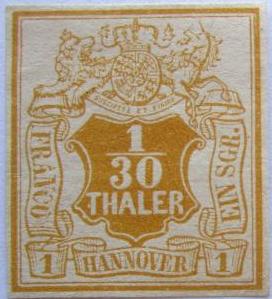



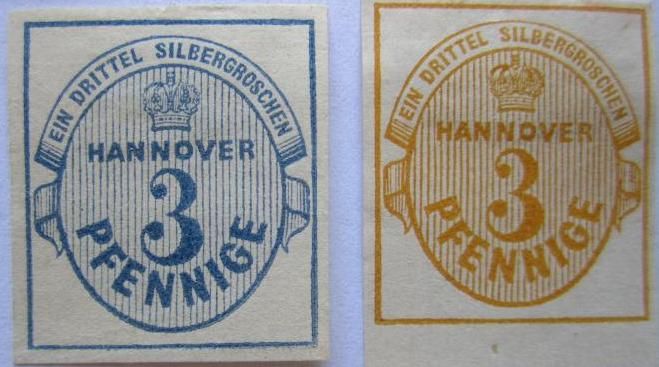
All pretending to be 'proofs', but more likely reprints.